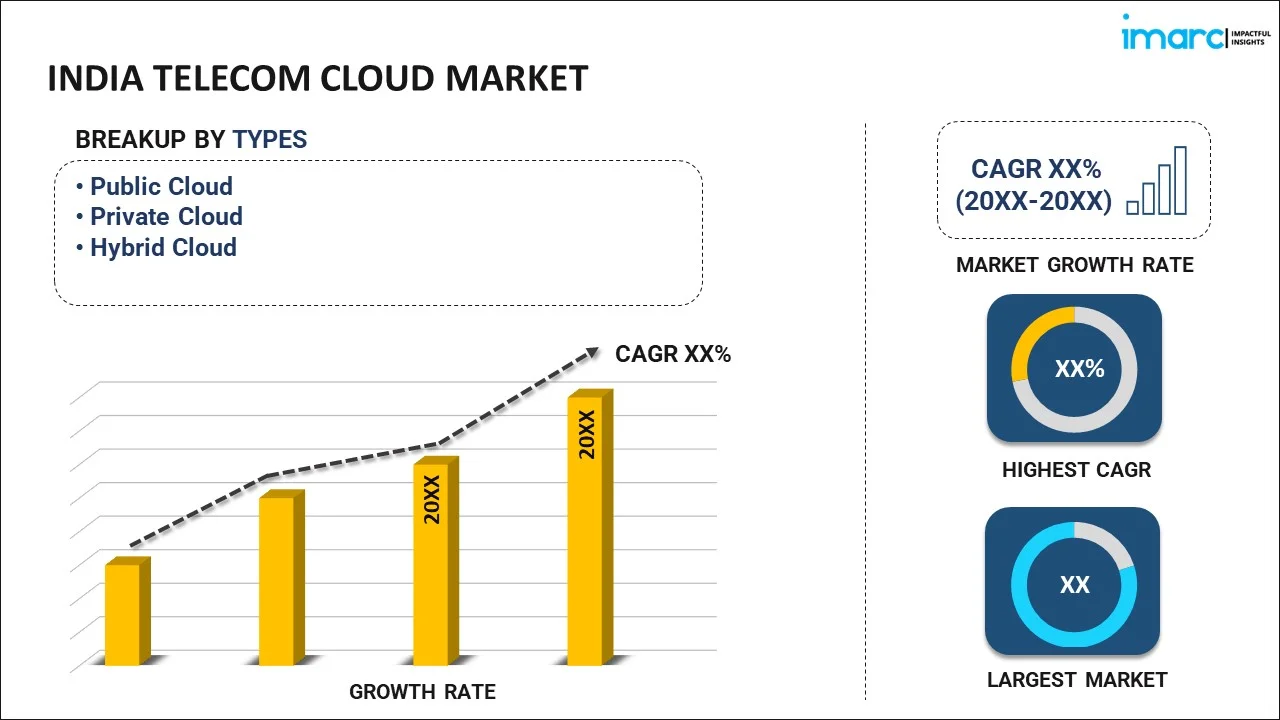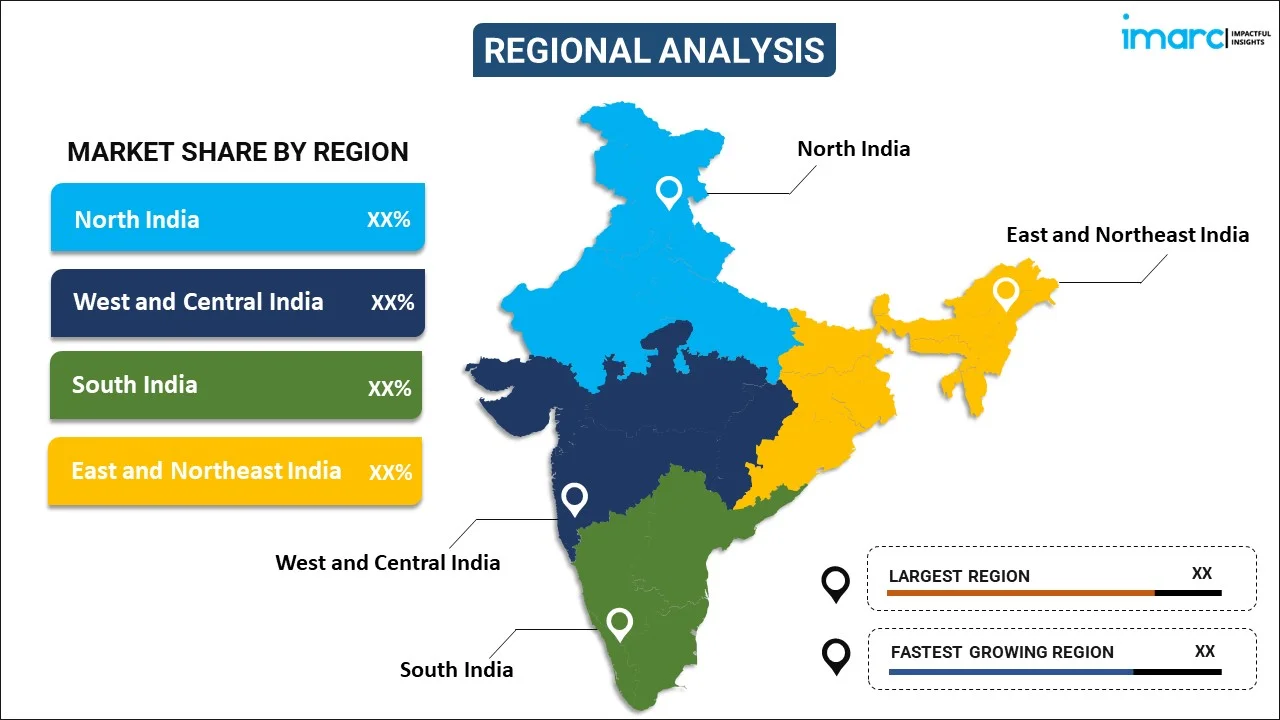
India Telecom Cloud Market Report by Type (Public Cloud, Private Cloud, Hybrid Cloud), Computing Service (SaaS, IaaS, PaaS), Application (Computing, Data Storage, Achieving, Enterprise Application, and Others), End User (BFSI, Retail, Manufacturing, Transportation and Distribution, Healthcare, Government, Media and Entertainment, and Others), and Region 2025-2033
Market Overview:
India telecom cloud market size reached USD 1,582.0 Million in 2024. Looking forward, IMARC Group expects the market to reach USD 9,595.8 Million by 2033, exhibiting a growth rate (CAGR) of 22.18% during 2025-2033. The increasing demand for telecom cloud solutions, which enable the delivery of innovative services and applications, enhancing the overall customer experience, is driving the market.
|
Report Attribute
|
Key Statistics
|
|---|---|
|
Base Year
|
2024 |
|
Forecast Years
|
2025-2033
|
|
Historical Years
|
2019-2024
|
| Market Size in 2024 | USD 1,582.0 Million |
| Market Forecast in 2033 | USD 9,595.8 Million |
| Market Growth Rate (2025-2033) | 22.18% |
Telecom cloud refers to the virtualized and scalable infrastructure that enables telecommunications services to be delivered over the internet. It leverages cloud computing technologies to provide on-demand access to a shared pool of resources, such as computing power, storage, and networking, allowing telecom operators to optimize their operations and services. The telecom cloud facilitates the deployment of network functions and services in a more flexible and cost-effective manner, promoting agility and innovation within the telecommunications industry. This cloud-based approach enhances scalability, allowing operators to dynamically adjust resources based on demand. It also supports the transition to 5G and the implementation of network functions virtualization (NFV) and software-defined networking (SDN), enabling more efficient and responsive telecommunications infrastructure. In essence, the telecom cloud represents a transformative paradigm for delivering and managing telecommunications services in a highly dynamic and adaptable manner.
India Telecom Cloud Market Trends:
The telecom cloud market in India is experiencing robust growth, primarily driven by a confluence of factors that underscore the transformative nature of the telecommunications industry. Firstly, the escalating demand for high-speed connectivity and seamless communication across diverse devices propels telecom operators to adopt cloud-based solutions. Consequently, the integration of 5G networks, a pivotal driver in itself, synergizes with cloud technologies to unlock unprecedented levels of speed and efficiency. Moreover, the increasing trend towards virtualization and network function virtualization (NFV) within the telecom sector reinforces the ascendancy of cloud solutions. This transition towards virtualized infrastructure enables telecom operators to enhance their network agility, scalability, and resource optimization. Furthermore, the imperative to reduce operational expenditures and enhance overall cost-efficiency serves as an intrinsic driver, compelling telecom companies to leverage the cost advantages offered by cloud-based services. In parallel, the burgeoning Internet of Things (IoT) ecosystem further amplifies the demand for robust and flexible cloud infrastructure. As IoT devices increase, the need for scalable, secure, and latency-sensitive networks becomes paramount, positioning the telecom cloud market as a linchpin for facilitating seamless IoT connectivity. In essence, the interplay of these multifaceted drivers underscores the telecom cloud market's trajectory as an indispensable force shaping the future of telecommunications.
India Telecom Cloud Market Segmentation:
IMARC Group provides an analysis of the key trends in each segment of the market, along with forecasts at the country level for 2025-2033. Our report has categorized the market based on type, computing services, application, and end user.
Type Insights:

- Public Cloud
- Private Cloud
- Hybrid Cloud
The report has provided a detailed breakup and analysis of the market based on the type. This includes public cloud, private cloud, and hybrid cloud.
Computing Services Insights:
- SaaS
- IaaS
- PaaS
A detailed breakup and analysis of the market based on the computing services have also been provided in the report. This includes SaaS, IaaS, and PaaS.
Application Insights:
- Computing
- Data Storage
- Achieving
- Enterprise Application
- Others
The report has provided a detailed breakup and analysis of the market based on the application. This includes computing, data storage, achieving, enterprise application, and others.
End User Insights:
- BFSI
- Retail
- Manufacturing
- Transportation and Distribution
- Healthcare
- Government
- Media and Entertainment
- Others
A detailed breakup and analysis of the market based on the end user have also been provided in the report. This includes BFSI, retail, manufacturing, transportation and distribution, healthcare, government, media and entertainment, and others.
Regional Insights:

- North India
- West and Central India
- South India
- East and Northeast India
The report has also provided a comprehensive analysis of all the major regional markets, which include North India, West and Central India, South India, and East and Northeast India.
Competitive Landscape:
The market research report has also provided a comprehensive analysis of the competitive landscape in the market. Competitive analysis such as market structure, key player positioning, top winning strategies, competitive dashboard, and company evaluation quadrant has been covered in the report. Also, detailed profiles of all major companies have been provided.
India Telecom Cloud Market Report Coverage:
| Report Features | Details |
|---|---|
| Base Year of the Analysis | 2024 |
| Historical Period | 2019-2024 |
| Forecast Period | 2025-2033 |
| Units | Million USD |
| Scope of the Report | Exploration of Historical Trends and Market Outlook, Industry Catalysts and Challenges, Segment-Wise Historical and Future Market Assessment:
|
| Types Covered | Public Cloud, Private Cloud, Hybrid Cloud |
| Computing Services Covered | SaaS, IaaS, PaaS |
| Applications Covered | Computing, Data Storage, Achieving, Enterprise Application, Others |
| End Users Covered | BFSI, Retail, Manufacturing, Transportation and Distribution, Healthcare, Government, Media and Entertainment, Others |
| Regions Covered | North India, West and Central India, South India, East and Northeast India |
| Customization Scope | 10% Free Customization |
| Post-Sale Analyst Support | 10-12 Weeks |
| Delivery Format | PDF and Excel through Email (We can also provide the editable version of the report in PPT/Word format on special request) |
Key Questions Answered in This Report:
- How has the India telecom cloud market performed so far and how will it perform in the coming years?
- What has been the impact of COVID-19 on the India telecom cloud market?
- What is the breakup of the India telecom cloud market on the basis of type?
- What is the breakup of the India telecom cloud market on the basis of computing Services?
- What is the breakup of the India telecom cloud market on the basis of application?
- What is the breakup of the India telecom cloud market on the basis of end user?
- What are the various stages in the value chain of the India telecom cloud market?
- What are the key driving factors and challenges in the India telecom cloud?
- What is the structure of the India telecom cloud market and who are the key players?
- What is the degree of competition in the India telecom cloud market?
Key Benefits for Stakeholders:
- IMARC’s industry report offers a comprehensive quantitative analysis of various market segments, historical and current market trends, market forecasts, and dynamics of the India telecom cloud market from 2019-2033.
- The research report provides the latest information on the market drivers, challenges, and opportunities in the India telecom cloud market.
- Porter's five forces analysis assist stakeholders in assessing the impact of new entrants, competitive rivalry, supplier power, buyer power, and the threat of substitution. It helps stakeholders to analyze the level of competition within the India telecom cloud industry and its attractiveness.
- Competitive landscape allows stakeholders to understand their competitive environment and provides an insight into the current positions of key players in the market.
Need more help?
- Speak to our experienced analysts for insights on the current market scenarios.
- Include additional segments and countries to customize the report as per your requirement.
- Gain an unparalleled competitive advantage in your domain by understanding how to utilize the report and positively impacting your operations and revenue.
- For further assistance, please connect with our analysts.
 Inquire Before Buying
Inquire Before Buying
 Speak to an Analyst
Speak to an Analyst
 Request Brochure
Request Brochure
 Request Customization
Request Customization




.webp)




.webp)












